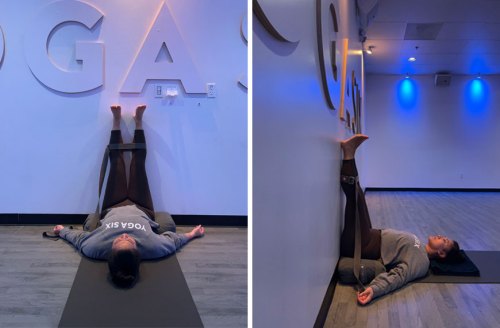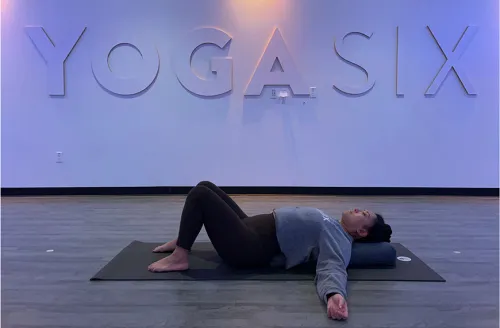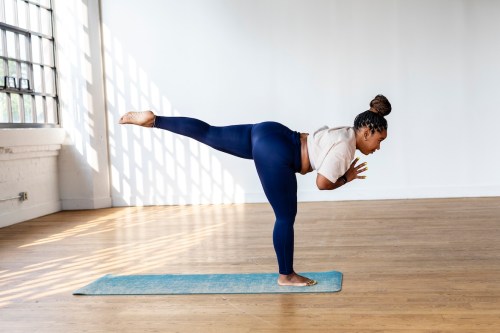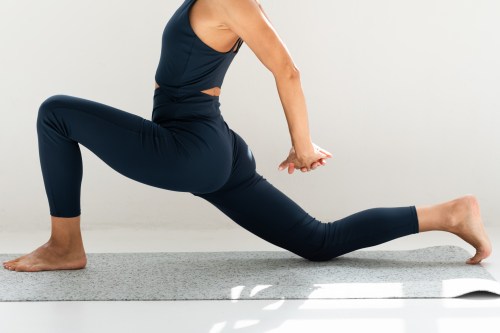When you think of heart-healthy workouts, hardcore cardio sessions probably come to mind. (Burpees! Sprints! Squat jumps!) While it’s true that going on a nice, long run or sweating your way through a HIIT class has noteworthy benefits for your ticker, there are also gentler ways to look out for your body’s all-important organ.
Experts in This Article
board-certified cardiologist and senior medical lead for Google Fit
In fact, Kapil Parakh, MD, a board-certified cardiologist and medical lead for Google Fit, says that unrolling your yoga mat and breathing through pose after pose has plenty of heart-healthy benefits.
The benefits of yoga for heart health
First things first, Dr. Parakh wants to remind you that all exercise is good for your heart. Period, end of story. That said, yoga has its own list of perks to brag about. The physical aspect of yoga, called “asana,” has been shown to lower blood pressure, improve cholesterol, and even lower blood sugar in diabetics. Yogic breathwork practices, or “pranayama,” have also been shown to improve heart health by regulating the autonomic nervous system, which helps your heart function properly.
“There is also an interesting mind-body connection,” Dr. Parakh says. “Yoga can help reduce stress, which if unmanaged, can lead to negative health effects, including an increased risk of cardiovascular disease,” he explains. Yep, that means your yoga practice is basically protecting your heart in a myriad of ways.
“Yoga can help reduce stress, which if unmanaged, can lead to negative health effects, including an increased risk of cardiovascular disease.” — Kapil Parakh, MD
Of course, Dr. Parakh recommends mixing up your workouts to reap the maximum, heart-healthy rewards of exercise.
“Science is increasingly showing that any type of physical activity has [heart] health benefits. It does not have to be strenuous activity in order to get cardiovascular benefits. Brisk walking is one of the most accessible forms of exercise and I often recommend it to my patients,” he says. “If you enjoy going to the gym, there are a wide range of options. You can use a treadmill, join a spin class, try a rower or use a stair climber. If you’re craving nature, go for a run, take a hike or go on a bike ride.”
He adds that strength training is also key for your cardiovascular health, so add some bodyweight or weight training to your rotation if your schedule allows.
Another important thing to note: “As a general rule, the American Heart Association and World Health Organization recommend reducing your time spent sedentary and instead encourage you to aim for 75 to 150 minutes of moderate to vigorous physical activity per week,” he says, pointing out that many wearables help you navigate your optimal heart rate zones with ease so you can make the most of your movement.
The best yoga poses for a healthy heart
The best yoga for heart health poses include restorative options that reduce anxiety and stress. As Well+Good has previously reported, these include the following:
1. Legs up the wall pose (Viparita Karani)

- 1.Place your yoga mat perpendicular to a wall and place a cushion right up against the wall.
- 2.Sit with your left side against the wall.
- 3.Gently turn your body to the left and carefully swing your legs up the wall.
- 4.Lower your back to the floor and lie down. Rest your shoulders and head on the floor.
- 5.Let your arms relax by your sides at an angle that feels comfortable for you.
- 6.Take deep breaths into your belly and long, slow exhalations to calm your nervous system.
- 7.After five to 10 minutes, draw your knees into your chest and roll to one side. Take a moment to pause before slowly coming up to a seated position.
2. Supported fish pose (Matsyasana)

- 1.Sit in front of the short end of your bolster or pillow. It should be touching your tailbone.
- 2.Use your arms for support as you lie back on your bolster. Your entire spine and head should be supported. Bend your knees, extend them long, or place your feet together with your knees open like a book—whichever position is most comfortable for you.
- 3.Relax for 10 to 15 minutes. Use your hands to sit up slowly. Take a moment to pause before moving.
3. Supported child’s pose (Balasana)

- 1.Kneel with your knees hip-width apart and big toes close together.
- 2.Slide one to two bolsters or pillows lengthwise between your thighs.
- 3.Sit back on your heels and rest your belly, chest, and head on your bolster.
- 4.Practice for six to 10 minutes, making sure to turn your head to one side halfway through.
- 5.To come out of the pose, place your hands on the floor under your shoulders and press up slowly to sit on your heels. Take a moment to pause before moving.
4. Supported reclining twist pose (Supta Matsyendrasana)

- 1.Start lying flat on your back with a pillow in between your thighs.
- 2.Bend both legs toward your chest, then let them fall to one side. Stack your knees and hips.
- 3.Extend your arms straight out at shoulder level and turn your head in the opposite direction from your knees.
- 4.Close your eyes and relax your jaw and belly. After three to five minutes, switch sides.
- 5.To come out, draw your knees to your chest then slowly lengthen them one at a time. Take a moment to pause before moving.
5. Corpse pose (Savasana)

- 1.Lie on your back with your arms out to the side and legs comfortably apart.
- 2.Relax and breathe for five to 20 minutes.
- 3.To come out, first bring small movements to your hands and feet. Bend your knees and roll over to one side.
- 4.Rest in this position until you feel ready to sit up. Take a moment to pause before moving.
The bottom line
Remember that your heart health is intertwined with other things besides your step count (like, say, what you eat and how much you sleep). So as you’re making moves to take better care of your ticker, keep in mind that small, holistic changes can add up. For now, however, hop on your mat for a heart-healthy yoga flow and know that a few cat-cows are enough.
FAQ
1. Which type of yoga is best for your heart?
Restorative yoga—aka gentle, relaxing poses that require little movement—is great for heart health. That’s because they reduce stress and regulate your nervous system. If stress goes unmanaged, it can increase your risk of heart disease, Dr. Parakh explains above.
2. Can yoga help with heart issues?
According to Johns Hopkins Medicine, yoga has been shown to improve metabolic syndrome, reduce the frequency of atrial fibrillation episodes, and improve exercise capacity and quality of life in those with heart failure.
That being said, chat with your doctor before starting a yoga practice, as there may be some things to take into consideration if you have a heart condition. Additionally, don’t continue doing yoga and let your doc know if you notice any health issues worsen.
Sign Up for Our Daily Newsletter
Get all the latest in wellness, trends, food, fitness, beauty, and more delivered right to your inbox.
Got it, you've been added to our email list.











